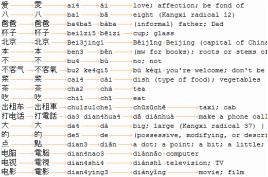Browse the Latest New HSK Word Lists
If you just want to take a look at the words without downloading anything, you can view the HSK 1-6 Words and HSK 1-6 Characters here. If you hover over words or characters you will see their word and/or character frequency index (1 being most frequent), and if you click on words or characters you can see their definitions and other information such as components and compounds. You can click 'expand definitions' to see more information about the words/characters right on that page.
If you just want to take a look at the words without downloading anything, you can view the HSK 1-6 Words and HSK 1-6 Characters here. If you hover over words or characters you will see their word and/or character frequency index (1 being most frequent), and if you click on words or characters you can see their definitions and other information such as components and compounds. You can click 'expand definitions' to see more information about the words/characters right on that page.
Download the Latest New HSK Word Lists

These files have been generated from the latest (as of November 2013) which word lists published by Hanban in September 2012. The lists are updated about every 2 years. In case their site is down, here is a copy of the original Excel file which they distribute.
The 'hanzi only' files are just that; a list of words in simplified characters, one per line. For the 'definitions and traditional' files each line is tab separated and contains simplified characters, traditional characters, pinyin (numbers), pinyin (tone marks), and then a definition. These files are in a format that allows them to be import directly into the Hanzi Stickystudy iPhone/iPad flashcard app, and can probably be tweaked for import into other flashcard systems.
Note that the HSK levels are cumulative but the lists aren't. Files are either ordered by pinyin (as published by Hanban) or by word frequency, using the SUBTLEX-CH word frequency data. Note that when ordering by frequency, characters used within a word were, if necessary, moved before they are used, e.g. 少 is placed just before 多少 even though 少 is less frequent.
The 'hanzi only' files are just that; a list of words in simplified characters, one per line. For the 'definitions and traditional' files each line is tab separated and contains simplified characters, traditional characters, pinyin (numbers), pinyin (tone marks), and then a definition. These files are in a format that allows them to be import directly into the Hanzi Stickystudy iPhone/iPad flashcard app, and can probably be tweaked for import into other flashcard systems.
Note that the HSK levels are cumulative but the lists aren't. Files are either ordered by pinyin (as published by Hanban) or by word frequency, using the SUBTLEX-CH word frequency data. Note that when ordering by frequency, characters used within a word were, if necessary, moved before they are used, e.g. 少 is placed just before 多少 even though 少 is less frequent.
- HSK 1: hanzi only (pinyin order), StickyStudy definitions and traditional (pinyin order), (frequency order)
- HSK 2: hanzi only (pinyin order), StickyStudy definitions and traditional (pinyin order), (frequency order)
- HSK 3: hanzi only (pinyin order), StickyStudy definitions and traditional (pinyin order), (frequency order)
- HSK 4: hanzi only (pinyin order), StickyStudy definitions and traditional (pinyin order), (frequency order)
- HSK 5: hanzi only (pinyin order), StickyStudy definitions and traditional (pinyin order), (frequency order)
- HSK 6: hanzi only (pinyin order), StickyStudy definitions and traditional (pinyin order), (frequency order)
- HSK 1-6: Pleco Flashcards (simplified, traditional, and pinyin, formatted for import into Pleco)
Skritter Lists
If you use Skritter, you could just use these Skritter vocabulary lists. There are two versions, in pinyin order and frequency order:
- HSK 1: pinyin order, frequency order
- HSK 2: pinyin order, frequency order
- HSK 3: pinyin order, frequency order
- HSK 4: pinyin order, frequency order
- HSK 5: pinyin order, frequency order
- HSK 6: pinyin order, frequency order
HSK Example Sentences
These tab-separated files contains example sentences that illustrate key HSK grammar points for HSK levels 1 to 3. Most are grammar examples taken from the official HSK documentation. I have added English translations and pinyin where needed:
- Example Sentences formatted for Pleco; simplified only, pinyin with tone marks
- Example Sentences formatted for Hanzi StickyStudy iOS app; simplified, traditional, pinyin with both tone marks and numbered tones
- 你为什么『生气』 shēngqì Why are you 『upset』?
Browse Files Directly
To browse the directory structure of word lists I have shared click here: https://github.com/glxxyz/hskhsk.com/tree/main/data/lists/